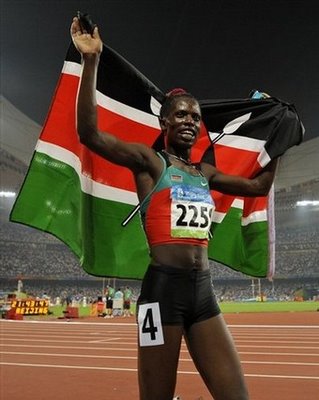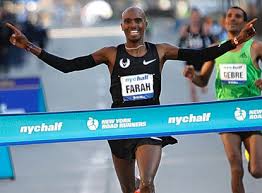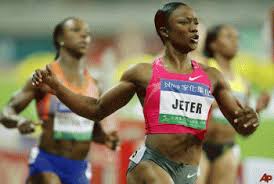Friday 6th May 2011
Today, the Guardian published a list of 10 reasons to watch athletics in 2011. Now, I’m not the type of person who needs 10 reasons to watch athletics, but I appreciate that others need more persuading. And with the Diamond League starting this evening in Doha, what better time to celebrate the world’s best athletes? Anna Kessel has picked out 10 athletes who are going to make an impact on the world stage this year. Now, I am a fan of Anna Kessel’s and she generally writes knowledgeably and entertainingly about athletics, but I felt that some of the picks were a little bit obvious. Usain Bolt, Blanka Vlasic, Jessica Ennis and David Rudisha are undoubtedly great athletes, but what about the other people who pass under the radar a bit? Here is my list of the track athletes who are going to have a good 2011 season.
Pamela Jelimo
With all the talk in the women’s 800 being dominated by the gender(s?) of Caster Semenya, it is easy to forget that there are actually other athletes who do this event. One of those is Pamela Jelimo, who is not only the third fastest woman ever to run half a mile, but is also the reigning Olympic Champion at the distance. She missed last season through a knee injury but if she can get anywhere near her form of 2008 when she ran an amazing 1:54, she will be unstoppable.

Silas Kiplagat
OK, maybe I’m going for the obvious choice here too but I can see Silas Kiplagat having a great 2011. Overshadowed by his compatriot Asbel Kiprop in the 1500 last year, the 21 year old is still a force to be reckoned with. Though he was not as succesful as Kiprop in the Diamond League, he still managed to run the fastest time in the world and became Commonwealth Champion. Not many people get under 3:30 but Kiplagat managed it with a 3:29.27 that puts him tenth on the world all time list. More of the same this year and we could see a new world champion in South Korea.

Allyson Felix
Moving from Kenyan middle distance runners to American sprinters, I’d like to explain why Allyson Felix will still be World Champion at the end of the year. A 200m specialist, she is rumoured to be doubling up in the 400 as well, whilst also competing in the 400 relay. Felix has run sub 11 for 100m, sub 22 for 200m and sub 50 for 400m, giving her a PB portfolio as impressive as her compatriot Tyson Gay. She has a great combination of pure speed and strength and will undoubtedly lead the way in the long sprints this year.

Mo Farah
I’m surprised the Guardian didn’t mention him. At a time when the standard of distance running in the British Isles leaves a lot to be desired, the NEB athlete represents the one beacon of hope for Great Britain. After a 2010 season in which he became double European Champion and broke 13 minutes for 5000m, Farah’s name can genuinely be uttered in the same breath as those of the Bekele brothers and just about anyone in Kenya. It will be interesting to see the effects of his move to the States to train with Alberto Salazar and Galen Rupp. As a fan of British athletics, I would love to see him do well. A good 2011 season would set him up nicely for next year’s Olympics in his home city of London.

Mahiedine Mekhissi
Why choose a French steeple chaser? Well, this man is the only one who looks like he’s anywhere near the Kenyans in ‘their’ event. The man can certainly shift over the barriers, as shown by his win in Barcelona last year to pick up European gold, and by his truly world class 8:02 clocking. Though he is no more than an outside shot for a medal at the worlds, this chaser of North African origin will definitely have the East Africans looking over their shoulders.

Carmelita Jeter
This woman is the second fastest woman ever over 100 metres. The only female athlete to have run faster is Florence Griffith Joyner, who may or may not have had chemical assistance to do so. Carmelita Jeter is another great American sprinter who will push her Jamaican rivals all the way to the line, and maybe even get there before them. She is in great shape for a woman in her 4th decade and could well be World 100m Champion by September.

So there you go: my picks for 2011. Maybe I will be proven wrong but amongst this collection of unsung heroes, returning greats, outside bets and proven world beaters are some fine athletes. Watch this space.
Thursday 5th May 2011
Yesterday evening I had a catch up with two of my closest running friends, the core of my training group and the guys I do several of my training sessions with every week. It was good fun. We sat in Mark’s living room, ate some pringles and popcorn, put our feet up and watched the full 3 hours of footage of the London Marathon. Ace.
Apart from our unanimous agreement that, amongst other things, Mary Keitany is a running goddess, Emmanuel Mutai is a machine from another planet, and that British men can’t run marathons, we were united in our view that none of us had really achieved what we had set out to at the start of our most recent marathon training cycle. First there was Mark, the evening’s host, who had got into great shape leading up to the Two Oceans Ultra Marathon (56km) in South Africa. He managed to run a 2:06 20 miler and a 16:12 5k in the two months leading up to the race and was well on course to break the 4 hour barrier and claim his first silver medal at the event. Illness in the weeks leading up to the race caused him to miss his target time, and he ran 4:17. Whilst this is a very respectable time for a hilly 35 mile race in the heat, Mark is the first to admit that he could have run quicker in different circumstances.
The second of the trio was Gracie, also afflicted by illness in the two weeks preceding his race, the London Marathon. A tough and strong willed man, he started the race despite not feeling 100% and began to struggle soon after the gun. To his great credit, he continued to the finish, running a time of 3:36, over half an hour slower than he had trained for. He had done the miles, done the sessions, but wasn’t able to cash in his banked mileage on the day.
Which leaves me. Readers of this blog will know that I had a bad day and didn’t even finish the London Marathon, having to be scraped off the pavement by a police officer somewhere in the Docklands. After four hard months of specific training, I don’t even have a marathon time to show for it. Not even a bad marathon time. No time.
Now it’s easy to view these setbacks as proof that our training was wrong, that we did the wrong work, that we were not adequately prepared to run the times we were claiming to be capable of. This might be true or it might not, but my personal view is that different forces were at play. Don’t worry; I’m not going to start making the classic mistake that losers make and start making excuses. I do feel, however that this was just a bad day. Well, three bad days.
What running teaches you is that you are not always going to be successful. You can have the perfect build up but still not deliver on the day. For every 5 great races you have, there will invariably be one stinker of a race, and it is more often that the one bad race of the six is the one that you remember the most. We spent a disproportionate amount of time reflecting on the bad things that happen, whilst forgetting to reflect on our successes. Arguably, this is what makes a successful athlete – the ability to learn from setbacks and build upon them. But I do feel that you must learn from the good as well as from the bad. Was it the mileage that helped you to that half marathon PB? Was it the hill sessions that gave you the strength to dig in on that last climb of the cross country race? Was it the extra rest day that you took the week before that helped you to the great 5k time?
This is one of the many ways in which running is a metaphor for life. Sometimes you fail. Sometimes you do not achieve what you had hoped. Sometimes you are disappointed. Admittedly, it is the hard working and the fortunate who are disappointed the least, but everyone has a bad day sometimes. Mine was on April 17th, and I am going to learn from it.
Monday 2nd May 2011
Of all the things that a runner can do to prepare himself for the start of track season, I would suggest that falling over in the road and smashing one’s knee does not represent the ideal preparation. Correct me if I’m wrong.
I went for my long run on Friday morning; unusual I know but my club mate Jack was up for it and the royal wedding was on, meaning a day off work. The other reason was that I had entered a track race today (Monday) and wanted to be fresh for it.
We had barely been going a minute when I ran across a road at pace, caught a bit of gravel and slipped, with my right knee taking most of the force of my fall. I wanted to become more familiar with the streets of Birmingham by trying out some new routes. This wasn’t what I meant. I left several layers of skin behind and my elbows, hands and knees are still pretty grazed. We carried on with the run, an excellent blast round the countryside and some cycle routes at a decent pace, but the next day my knee really started hurting. I think it’s just a bit of bruising and muscle tissue damage, but I will try and get to a physio this week and get their verdict. In the mean time I’m taking a full week off running, and icing my knee to calm the inflammation, with the hope that I should be OK for my next scheduled race on Saturday. I had a very similar injury last year and I delayed my recovery by rushing back; I’m trying to be a bit more sensible this time round.
Fingers crossed.
Sunday 3rd April 2011
Here is the first chapter of one of my favourite books about running.
It is called ‘Running: A Global History’ and is written by Thor Gotaas. I would definitely recommend it!
The chapter is called Messengers and Forerunners.
Friday 1st April 2011
http://www.flotrack.org/embed/Nzk4MzU5MTg5
Watch more video of 2010 Chicago Marathon on flotrack.org
I don’t know how anyone can run that fast at the end of a marathon. One of many great duels between Wanjiru and Kebede. Shame there will be no repeat at London…



